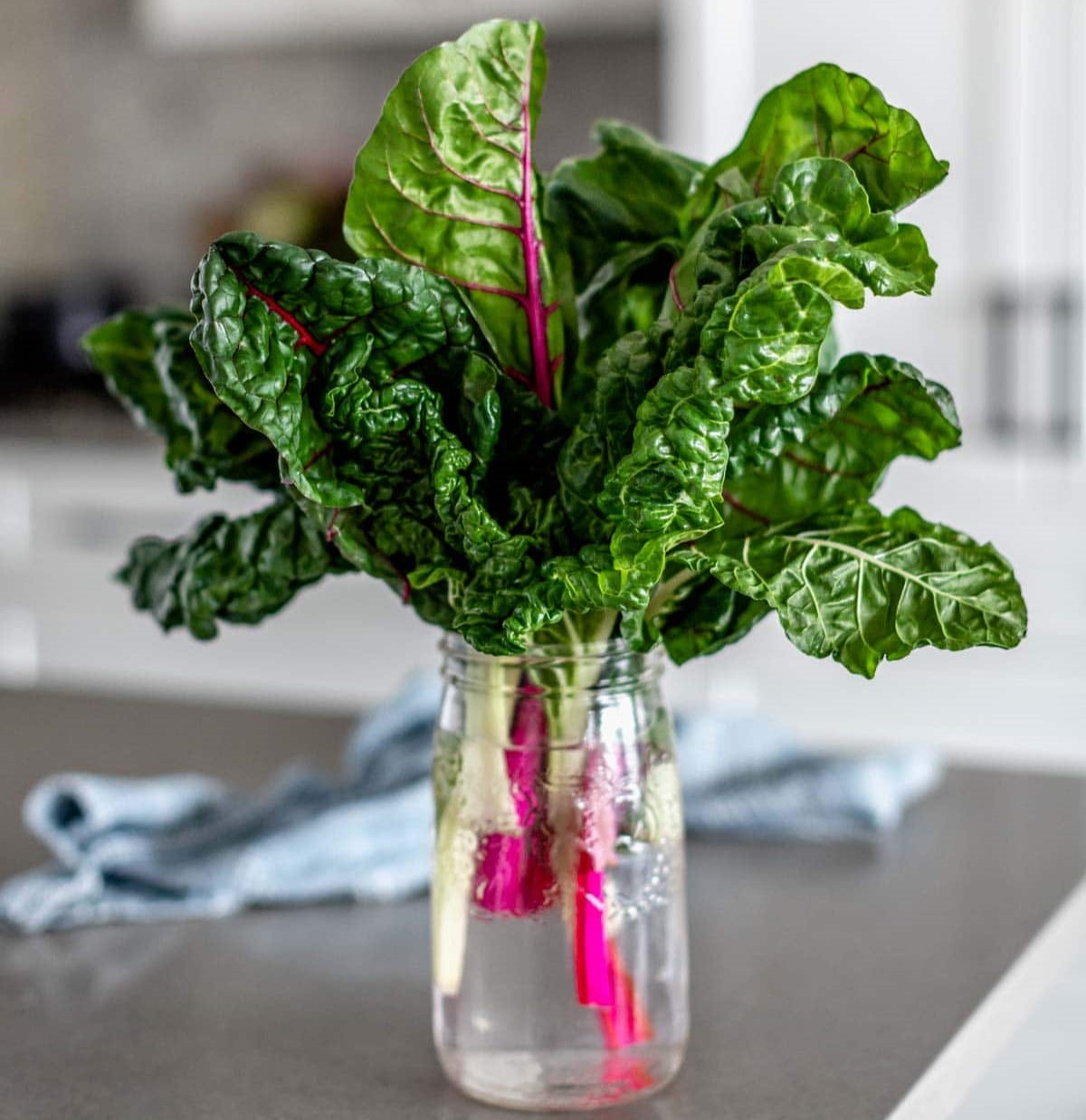

Articles
How To Store Chard
Modified: February 28, 2024
Learn the best methods for preserving and storing chard with our informative articles. Keep your chard fresh and delicious for longer with expert tips and techniques.
(Many of the links in this article redirect to a specific reviewed product. Your purchase of these products through affiliate links helps to generate commission for Storables.com, at no extra cost. Learn more)
Introduction
Welcome to our comprehensive guide on how to store chard! If you’re a fan of this nutritious leafy green vegetable, then you probably know that properly storing chard is essential to preserve its flavor, texture, and overall quality. Whether you’ve grown your own chard or purchased it from the market, understanding the best storage techniques will help you maximize its freshness and extend its shelf life.
Chard, also known as Swiss chard or silver beet, belongs to the same family as beets and spinach. It is packed with vitamins, minerals, and antioxidants, making it a great addition to a healthy diet. However, if not stored correctly, chard can quickly lose its nutritional value and become wilted or spoiled.
In this guide, we will explore the optimal conditions for storing chard, discuss the steps involved in harvesting and preparing it for storage, and explore various storage methods, including refrigeration and freezing. We will also provide some helpful tips and tricks for long-term storage, as well
Key Takeaways:
- Proper storage is crucial for preserving chard’s nutritional value, freshness, and texture. By following optimal storage conditions and preparation techniques, you can extend its shelf life and minimize food waste.
- Refrigeration and freezing are effective methods for storing chard, allowing you to enjoy its goodness for up to several months. Utilize creative recipes to make the most out of your stored chard and savor its flavorful and nutritious benefits.
Read more: How To Store Swiss Chard
Why is proper storage important for chard?
Proper storage is crucial for chard to maintain its freshness, taste, and nutritional value. A well-stored chard will have vibrant green leaves and crisp stems, while a poorly-stored chard can quickly become wilted, slimy, or discolored.
Here are a few reasons why you should pay attention to the storage of your chard:
Preserving Nutritional Value
Chard is packed with essential vitamins and minerals, including vitamin K, vitamin A, vitamin C, iron, and magnesium. These nutrients are vital for maintaining good health and well-being. However, improper storage can lead to nutrient loss, significantly diminishing the nutritional value of the vegetable. By storing chard correctly, you can help preserve its nutritional content and enjoy its health benefits to the fullest.
Maintaining Freshness and Texture
Chard is known for its tender leaves and crunchy stems. When stored properly, the leaves remain crisp, and the stems retain their freshness, ensuring a delightful texture when cooked or added to salads. On the other hand, improper storage can cause the chard to become limp, wilted, and unappetizing.
Minimizing Food Waste
Proper storage helps in reducing food waste. When chard is stored correctly, its shelf life is extended, allowing you more time to consume it before it spoils. This is particularly important if you have a surplus of chard from your garden or if you purchased it in bulk. Storing chard properly ensures that you can enjoy it for a longer period, minimizing the need to throw away wilted or spoiled portions.
Read more: How To Store Red Chard
Cutting Costs
Chard can be quite expensive, especially if you need to buy it out of season. By storing it properly, you can take advantage of sales or harvests and stock up on fresh chard to use later. This can help you save money by avoiding frequent purchases at higher prices. Proper storage transforms chard into a cost-effective ingredient in your kitchen.
Overall, proper storage for chard is essential to maintain its nutritional value, preserve its freshness and texture, minimize food waste, and save money. In the following sections, we will delve into the best conditions for storing chard and discuss the steps involved in harvesting and preparing it for storage.
Best conditions for storing chard
Creating the optimal storage conditions for chard is crucial in prolonging its freshness and preserving its quality. Here are the key factors to consider:
Temperature
Chard is a cool-weather vegetable and prefers temperatures between 32°F (0°C) and 40°F (4°C). It is best stored in the refrigerator, where the temperature can be set to these levels. Avoid storing chard near the freezer section, as it may freeze and become damaged.
Humidity
Chard prefers high humidity levels to prevent wilting. The ideal humidity range for storing chard is between 90% and 95%. To maintain the required humidity, store chard in perforated plastic bags or wrap it in a damp paper towel before placing it in the refrigerator.
Read more: How To Store Rainbow Chard
Air Circulation
Good air circulation is essential to prevent moisture buildup and inhibit the growth of mold and bacteria. Avoid overcrowding chard in the refrigerator, as this can restrict airflow. Give the leaves and stems some space to breathe by storing them loosely or using open containers.
Light
Chard does not require direct sunlight once it has been harvested. Exposure to light can cause the leaves to wither and lose their vibrant color. Store chard in a dark location, such as the crisper drawer of the refrigerator, or cover it with a paper towel or cloth to block out light.
Separation from Certain Produce
Chard is sensitive to ethylene gas, a natural plant hormone that promotes ripening and can cause premature spoilage in some fruits and vegetables. To prevent the influence of ethylene, store chard separately from ethylene-producing vegetables such as apples, bananas, and tomatoes.
By following these guidelines, you can create the best conditions for storing chard and extend its shelf life. In the next section, we will discuss the proper techniques for harvesting chard to ensure optimal freshness.
Harvesting chard for storage
Harvesting chard correctly is the first step towards ensuring its optimal freshness and longevity in storage. Here are some guidelines to follow when harvesting chard for storage:
Read more: How To Store Swiss Chard In The Fridge
Timing
Chard can be harvested at any stage of growth, depending on your preference. However, for storage purposes, it is best to wait until the leaves have reached a reasonable size, usually around 8-10 inches (20-25 cm) in length. This ensures that the chard has developed enough nutrients and flavor.
Leaf Selection
When selecting chard leaves for harvest, look for those that are vibrant green and free from signs of damage or disease. Avoid harvesting leaves that are yellowed, wilted, or have brown spots, as these may indicate deterioration. Opt for young, tender leaves when possible, as they are more flavorful.
Stem Cutting
To harvest chard, use a sharp knife or garden shears to cut the stems approximately 1-2 inches (2.5-5 cm) above the soil level. The goal is to leave a portion of the stem attached to the plant to promote regrowth. Avoid pulling or uprooting the entire plant, as this can damage the roots and affect future growth.
Leaf Removal
After harvesting the stems, remove the leaves from the stems. Separate the leaves carefully, ensuring there are no damaged or bruised areas. Trim off any tough or fibrous parts of the stems, as these can detract from the overall quality of the chard.
Read more: How To Germinate Swiss Chard
Cleaning
Once the chard leaves and stems have been harvested and separated, it is essential to clean them thoroughly to remove any dirt, debris, or insects. Rinse the leaves and stems under cold water, gently swishing them to dislodge any trapped particles. Pat them dry with a clean kitchen towel or use a salad spinner to remove excess moisture.
By following these harvesting guidelines, you can ensure that your chard is at its best when it comes time to store it. In the next section, we will discuss the steps involved in preparing chard for storage to maximize its shelf life.
Preparing chard for storage
Properly preparing chard for storage is essential to maintain its freshness and quality over an extended period. Here is a step-by-step guide on how to prepare chard for storage:
Remove Excess Moisture
Before storing chard, it is crucial to remove any excess moisture from the leaves and stems. Excess moisture can lead to wilting and promote the growth of bacteria or mold. Gently pat the chard dry using a clean kitchen towel or use a salad spinner to remove excess water.
Separate the Leaves and Stems
Once the chard has been washed and dried, separate the leaves from the stems. This will make it easier to store and also helps to prevent the stems from becoming soggy. Trim off any tough or fibrous parts of the stems, as these can impact the overall quality of the chard during storage.
Read more: How Long Swiss Chard Germinate
Cut into Desired Sizes
Depending on how you plan to use the chard, you may want to cut it into smaller or more manageable pieces. Slice the chard leaves and stems into the desired sizes, keeping in mind that smaller pieces may be more convenient for certain recipes, while larger pieces may be preferred for other cooking methods.
Blanching (Optional)
If you prefer to preserve the chard in its raw state, skip this step. However, if you want to preserve the color, texture, and nutrients of the chard for an extended period, consider blanching it briefly before storage. Bring a pot of water to a boil, then submerge the chard leaves and stems in the boiling water for about 2-3 minutes. Remove and immediately transfer to an ice bath to stop the cooking process. Pat dry before proceeding.
Package for Storage
The way you package chard for storage will depend on whether you plan to store it in the refrigerator or freezer. For refrigerator storage, place the chard in a perforated plastic bag to maintain the desired humidity levels. Alternatively, you can wrap the chard loosely in a damp paper towel and then place it in a plastic bag with small holes to promote air circulation.
If you plan to freeze the chard, it is recommended to use airtight freezer bags or vacuum-sealed bags. Ensure the bags are completely sealed to prevent freezer burn.
Remember to label the packaging with the date of storage to keep track of its freshness.
By following these steps to prepare chard for storage, you can maximize its shelf life and enjoy its freshness for an extended period. In the next sections, we will discuss the specifics of storing chard in the refrigerator and freezer.
Storing chard in the refrigerator
Refrigeration is one of the best methods for storing chard, as it helps to maintain its crispness and slow down the wilting process. Follow these steps to store chard in the refrigerator:
Read more: When To Plant Swiss Chard Seeds
Step 1: Preparing for Refrigeration
Place the clean and dry chard leaves and stems in a perforated plastic bag or wrap them loosely in a damp paper towel. This will help to maintain the desired humidity levels and prevent the chard from drying out.
Step 2: Proper Placement in the Refrigerator
Store the chard in the refrigerator’s crisper drawer, which is designed to help maintain higher humidity levels. If you have limited space in the crisper, you can also place the chard on a shelf, making sure to keep it away from any strong-smelling foods that can transfer odors.
Step 3: Storage Duration
Freshly harvested chard can usually be stored in the refrigerator for up to 5-7 days. However, it is always best to check the leaves and stems for any signs of wilting or spoilage before use.
Step 4: Checking for Freshness
Before using the refrigerated chard, inspect it for any slime, mold, or discoloration. If you notice any of these signs, discard the affected parts and use the remaining chard promptly.
Remember, the quality of chard can deteriorate over time, so it is always recommended to consume it as soon as possible for the best taste and nutritional value.
In the next section, we will discuss an alternative method for long-term storage – freezing chard.
Read more: How To Store Store-Bought Bread
Storing chard in the freezer
If you have an abundance of chard or want to preserve it for an extended period, freezing is a great option. Freezing chard helps to retain its nutrition and allows you to enjoy it even when it is out of season. Here is a step-by-step guide for storing chard in the freezer:
Step 1: Blanching
Blanching is an optional but highly recommended step for freezing chard. Blanching helps to preserve the color, texture, and nutrients of the chard. Start by bringing a large pot of water to a boil, then submerge the chard leaves and stems in the boiling water for about 2 minutes. Remove and immediately transfer to an ice bath to cool and stop the cooking process.
Step 2: Remove Excess Moisture
After blanching, drain the chard and gently squeeze out any excess moisture. This will help prevent freezer burn and preserve the chard’s quality during freezing.
Step 3: Portioning
If you prefer to freeze the chard in individual servings, separate it into portion-sized quantities. This will make it easier to thaw and use only what you need without having to defrost the entire batch.
Read more: How To Store Basil From Store
Step 4: Packaging
Place the blanched and dried chard into airtight freezer bags or vacuum-sealed bags. Squeeze out as much air as possible before sealing to prevent freezer burn. Label the bags with the date of freezing for future reference.
Step 5: Freezer Placement
Store the chard in the freezer, making sure it lies flat to prevent it from sticking together. The optimal temperature for freezing chard is 0°F (-18°C) or below.
Step 6: Storage Duration
Frozen chard can typically be stored for up to 8-12 months without significant loss in quality. However, it is recommended to use it within 3-6 months for the best taste and texture.
Step 7: Thawing and Using
To thaw frozen chard, remove the desired quantity from the freezer and let it thaw in the refrigerator overnight. Once thawed, the chard can be used in various dishes, such as soups, stews, stir-fries, or sautés. Avoid refreezing thawed chard, as it can lead to a loss in flavor and texture.
By following these steps, you can successfully store chard in the freezer, ensuring that you can enjoy its goodness throughout the year. In the next section, we will share some additional tips for storing chard long-term.
Read more: How To Store Basil From Grocery Store
Tips for storing chard long-term
For those who want to store chard for an even longer period, here are some additional tips to ensure optimal freshness and quality:
Choose Fresh Chard
When selecting chard for long-term storage, choose fresh and healthy-looking leaves and stems. Avoid chard that has already started to wilt or shows signs of damage or disease, as these will not store well.
Store Unwashed
It is best to store chard unwashed until you are ready to use it. Excess moisture can cause the chard to deteriorate quickly, so only wash the leaves and stems right before cooking or consuming.
Regularly Check for Spoilage
Even with proper storage techniques, chard can still spoil over time. Regularly inspect your stored chard for any signs of wilting, slime, mold, or off odors. Remove any spoiled portions to prevent further deterioration of the remaining chard.
Read more: How To Store Bruschetta
Consider Vacuum Sealing
Using a vacuum sealer can help minimize air exposure and reduce freezer burn. Vacuum-sealed packages also take up less space in the freezer, allowing you to store other items more efficiently.
Keep Track of Storage Dates
Labeling your stored chard with the date of storage is crucial for keeping track of its freshness. This will help you prioritize and use older chard first, ensuring that none of your chard goes to waste.
Experiment with Preservation Methods
While refrigeration and freezing are the most common methods for storing chard, you can also explore other preservation techniques. For example, you can blanch chard and then dehydrate it for long-term storage as well. Dehydrated chard can be used in soups, casseroles, or rehydrated for other dishes.
By following these tips, you can store chard for an extended period and enjoy its freshness and nutritional benefits whenever you desire. In the next section, we will discuss how to make the most out of your stored chard in various recipes.
Using stored chard effectively
With your well-stored and preserved chard at hand, it’s time to put it to good use in various recipes. Here are some ways to effectively use your stored chard:
Read more: How To Store Brushes
Sautéed Chard
Sautéing is a simple and flavorful way to prepare chard. Heat some olive oil or butter in a pan, add chopped garlic or onions, and sauté the chard until it wilts. Season with salt, pepper, and any other preferred herbs or spices. Serve as a side dish or mix it into pasta, quiches, or omelets for added nutrition.
Add to Soups and Stews
Chard adds a delightful flavor and texture to soups and stews. Whether it’s a hearty vegetable soup or a comforting minestrone, chop or tear the chard leaves and stems and add them to the pot during the last few minutes of cooking. The chard will wilt and infuse the dish with its goodness.
Smoothies and Juices
If you’re a fan of green smoothies or juices, adding a handful of chard to your blend can elevate the nutritional profile and add a vibrant green color. Combine chard with fruits, vegetables, and a liquid base of your choice for a refreshing and healthy beverage.
Stuffed Chard Rolls
Chard leaves can be used to make delicious stuffed rolls. Blanch the chard leaves to soften them before filling them with a mixture of rice, quinoa, vegetables, or meat. Roll the leaves up and bake them in a flavorful sauce for a tasty and wholesome meal.
Read more: How To Store Tallow
Chard Chips
Turn your chard into crispy and nutritious chips. Toss the chard leaves with olive oil, salt, and your favorite seasonings. Arrange them in a single layer on a baking sheet and bake at a low temperature until crispy. Enjoy the chard chips as a healthy and guilt-free snack.
These are just a few ideas to inspire you to use your stored chard effectively. Feel free to get creative and experiment with different recipes, such as chard lasagna, chard wraps, or chard pesto. The versatility of chard allows you to incorporate it into a wide range of dishes, adding a burst of flavor and nutrition.
Before we conclude, let’s summarize the key points we’ve covered in this guide on storing chard.
Conclusion
Proper storage is essential for keeping chard fresh, flavorful, and nutritious. Whether you have harvested chard from your garden or purchased it from the market, implementing the right storage methods will ensure that you can enjoy this leafy green vegetable for an extended period.
We discussed the best conditions for storing chard, including temperature, humidity, air circulation, and light. By following these guidelines, you can create an optimal environment for maintaining chard’s quality and prolonging its shelf life.
We also covered the important steps involved in harvesting and preparing chard for storage. Harvesting at the right time, separating the leaves and stems, and properly cleaning and preparing the chard are crucial to preserving its freshness and taste.
Understanding the different storage methods is key. Storing chard in the refrigerator allows you to keep it fresh for up to a week, while freezing it extends its shelf life up to several months. By blanching and packaging chard properly before freezing it, you can better preserve its color, texture, and nutrients.
We shared additional tips for long-term storage, including choosing fresh chard, storing it unwashed, regularly checking for spoilage, and considering vacuum sealing for freezer storage. These tips will help you make the most of your stored chard and minimize food waste.
Lastly, we explored various ways to use stored chard effectively in your cooking. From sautéing and adding it to soups and stews to making smoothies, stuffed rolls, or crispy chard chips, chard offers versatility and nutritious options for your meals.
With the knowledge and insights gained from this guide, you are now equipped to store and use chard effectively, ensuring that you can enjoy its goodness throughout the year. So go ahead, stock up on chard, and savor its flavorful and nutritious benefits in your favorite recipes!
Frequently Asked Questions about How To Store Chard
Was this page helpful?
At Storables.com, we guarantee accurate and reliable information. Our content, validated by Expert Board Contributors, is crafted following stringent Editorial Policies. We're committed to providing you with well-researched, expert-backed insights for all your informational needs.




0 thoughts on “How To Store Chard”